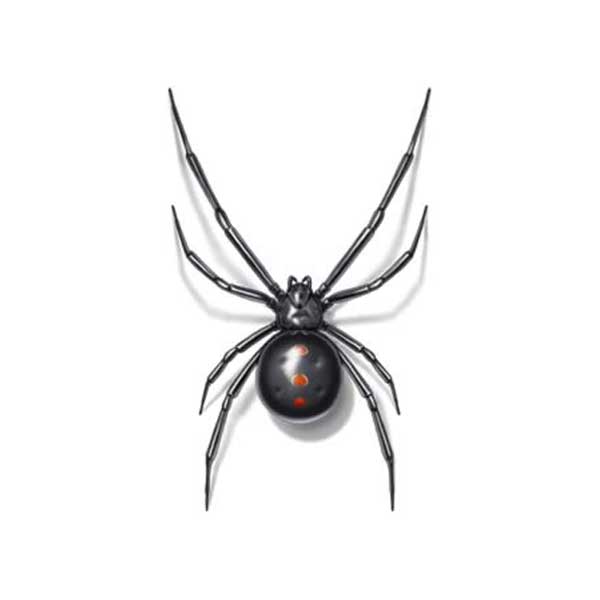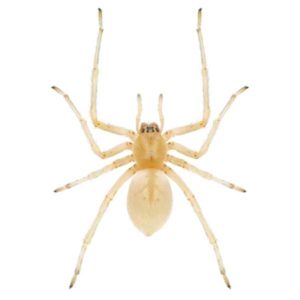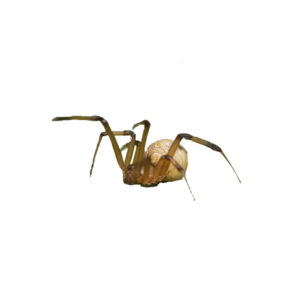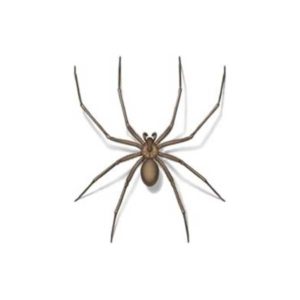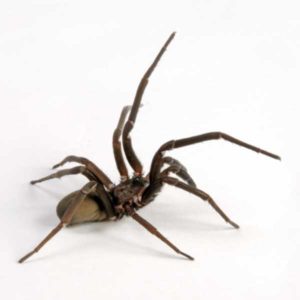Black Widow Spider Identification
What Do Black Widow Spiders Look Like?
Amongst the variety of spider species found in North Carolina, Black widow spiders are one of the most easily identifiable with their glossy black bodies and their distinctive red markings on their abdomen, often resembling an hourglass shape. Adult females, typically larger, range from ½ to 1 ½ inches in size. Males are smaller and less colorful. This contrast in appearance between genders is a key characteristic in spider identification. Their eight legs and round abdomen further distinguish them from other common spider species in North Carolina.
Signs of a Black Widow Spider Infestation
The primary indicator of a black widow infestation is the presence of their unique webs. These webs are irregular, messy, and lack a symmetrical pattern, unlike the webs of many other spider species.
Habitat, Diet, Life Cycle & Bites
Where Do Black Widow Spiders Live?
Black widow spiders in North Carolina favor outdoor habitats that are quiet, dark, and undisturbed. They are commonly found in rock piles, block walls, sprinkler valve boxes, and the undersides of patio furniture. They also make their homes in garages, outdoor sheds, and playground equipment. They prefer to stay outdoors but can be brought into homes inadvertently through boxes or furniture.
Diet of a Black Widow Spider
Their diet consists primarily of insects such as flies, mosquitoes, grasshoppers, beetles, and caterpillars. They are skilled predators, using their webs to trap their prey. After capturing their prey, they use their potent venom to immobilize and digest it, playing a crucial role in controlling pest populations.
Life Cycle of a Black Widow Spider
The life cycle of a black widow spider involves several stages. Females lay eggs in silken egg sacs, each containing hundreds of eggs. Spiderlings hatch and undergo several molts before reaching maturity. Females can live for up to three years, much longer than males.
Black Widow Spider Bites
These spiders will only bite if provoked, commonly when they’re pinched, squeezed, or pressed. Most bites happen when a human accidentally brushes a hand against a black widow, typically when reaching to grab an item, or cleaning out a dark space. Symptoms can manifest within 20 minutes to an hour and may include intense pain, stiffness, nausea, chills, and fever. While rarely fatal, bites should be treated as a medical emergency, especially for children and the elderly.
Are Black Widow Spiders Dangerous?
Black widow spiders possess a venom 15 times stronger than that of a rattlesnake. However, they are typically non-aggressive and bite humans only in self-defense. The venom can cause significant health issues, but fatalities are extremely rare, thanks to the availability of medical care and antivenom.
How to Get Rid of Black Widow Spiders?
The most effective way to get rid of black widow spiders is through professional extermination. DIY methods can be risky due to the spiders’ venomous nature.
Black Widow Spider Prevention Tips
To prevent black widow spiders, eliminate their preferred habitats around your property. This includes clearing clutter, sealing cracks and crevices in building exteriors, and regularly inspecting and cleaning garages, sheds, and storage areas. Use of insecticides in known habitats can also deter them from settling.
Need help with Black Widow Spiders control?
FAQs
How to Identify a Black Widow Spider?
You can identify a black widow spider by its shiny black body, red hourglass marking on the underside, and irregular webs. They are typically found in undisturbed, dark areas.
Are Black Widows Common in North Carolina?
Yes, black widows are a common spider species in North Carolina, particularly in outdoor areas where they can find secluded, undisturbed spaces.
What Should I Do If I Find a Black Widow?
How to handle the situation without disturbing the spider or its web, here are some steps you can take:
1) Do Not Touch or Approach: Black widow spiders are venomous, and their bites can be harmful. Avoid direct contact with the spider.
2) Observe From a Safe Distance: Keep a safe distance from the black widow spider to prevent accidental contact. Observe its location and behavior from afar.
3) Identify the Black Widow Spider: Make sure you correctly identify the spider as a black widow. They are typically shiny black with a red or orange hourglass-shaped mark on the underside of their abdomen. This marking is a distinctive feature of female black widows.
4) Do Not Disturb the Web: Black widow spiders are known for their intricate webs. Avoid disrupting the web to minimize the chances of the spider feeling threatened.
5) Keep Children and Pets Away: If the spider is in an area accessible to children or pets, ensure that they stay away from it. Educate them about the importance of not touching or disturbing spiders in the wild.
Remember, black widow spiders are generally not aggressive and will only bite if they feel threatened. If you accidentally get bitten or suspect a bite, seek medical attention promptly. Symptoms of a black widow spider bite may include pain, muscle cramps, and other systemic effects.

